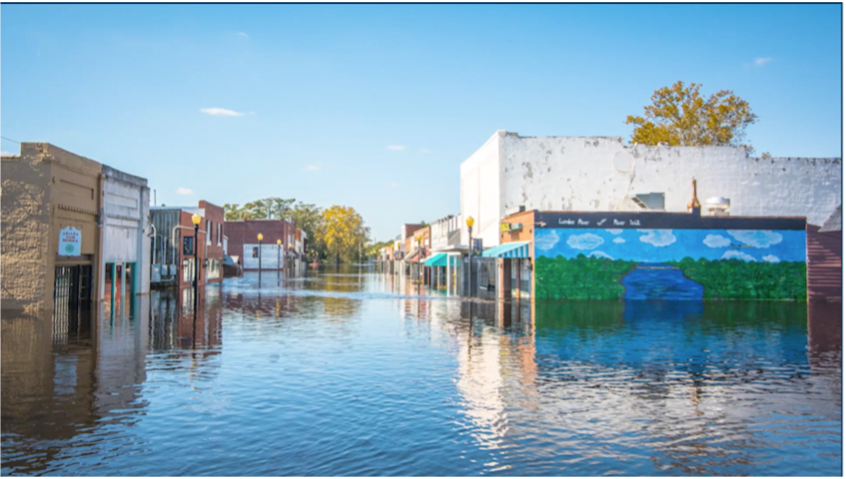Coastal Resilience in the Wilmington Region
In the past 5 years, Hurricanes Matthew and Florence caused massive amounts of damage in southeast North Carolina lasting for years beyond landfall. Municipalities and education institutions in the region are implementing measures to improve their resiliency in anticipation of future storm events. Watch our PBS NC ncIMPACT Town Hall series episode on this topic by clicking the link at the end of the blog.

The Problem
In recent years, coastal North Carolina experienced increasing severe weather events. This issue is critical in the Cape Fear Region of the state, where two devastating hurricanes caused significant damage in the past five years. In 2016, Hurricane Matthew caused massive flooding in the region, resulting in $1.5 billion in damages affecting over 100,000 buildings. In 2018, Hurricane Florence produced massive storm surges, closing off major sections of I-40 and effectively isolating Wilmington and New Hanover County from the rest of the state for several days. These types of storms and events are not going away and residents will continue to experience their effects. The challenge for local governments is responding to the increased frequency of these storms to protect the safety of their residents and strengthen their infrastructure. Watch this clip from the town hall event ncIMPACT Initiative hosted on this topic in September 2021.
The Solution
UNC-Wilmington is stepping up to train future leaders in mitigating storm damage and promoting resiliency in the region. The university recently launched a new curriculum in Coastal Engineering, the first of its kind in the nation. Students enrolled in the program take classes in physics, coastal processes, and geospatial analysis, among others, to learn how to manage the ever-changing nature of our coastlines. In addition to classroom experience, students have opportunities to learn real-world skills working in the region. One of these projects involves the effects of climate change and future storms on barrier islands. Students work in the field, taking measurements and recording observations, on Masonboro Island to capture some of these effects. Given the increasing frequency of storms and the danger associated with them, there is increasing demand for these types of work.
Local governments are also taking steps to mitigate the effects of storm damage, particularly related to flooding. By planning for the long-term and correctly managing land resources, coastal and inland communities are able to use the natural processes of the Earth to reduce the impact of flooding. Using permeable surfaces when creating parking lots allows water to return to the ground, rather than causing damage in the form of run-off. Similarly, allowing dunes to build up and fortifying them with native grasses can help beach-front communities stay resilient against storm surge from hurricanes. Abiding by these principles when discussing land use management also sets the tone for private developers in the area to begin thinking long-term when building new houses or commercial buildings. Watch this video of local leaders discussing these strategies.
The Players
Issues involving natural resource management and storm damage mitigation do not respect county or municipal boundaries. It takes a coordinated effort between partners in the region to achieve long-term resiliency. Local leaders from New Hanover, Pender, Onslow, Brunswick, Columbus, Robeson, Lenoir, and Bladen Counties, as well as other area municipalities, came together in early 2021 to form the Eastern NC Disaster Recovery & Resiliency Alliance. This group petitioned the Governor and General Assembly for increased resources to recover from previous storms and prepare for future ones.
The Promise
Their efforts resulted in the creation of HB 500, the Disaster Relief and Mitigation Act of 2021, which received bipartisan support among General Assembly members. HB 500 included funding to create additional resiliency programming positions and allocate funds for resiliency projects across the region, some of which were incorporated into the recently passed state budget. Many of these projects target specific communities.
- At the mouth of the Cape Fear River in Brunswick County, the Town of Southport will receive $5 million for waterfront stabilization after sustaining storm damage.
- Similarly, the town of Fair Bluff, a community in Columbus County that was severely impacted by Hurricane Matthew, will receive $500,000 to repair damaged buildings.
- The newly passed budget also includes funding to the North Carolina Office of Recovery and Resiliency to hire additional staff members. These officials will work with communities to help them plan for resiliency and administer grant funding to help communities implement new resiliency strategies.
The Town Hall
Watch our PBS NC ncIMPACT Town Hall series on this topic and more by clicking this link.


